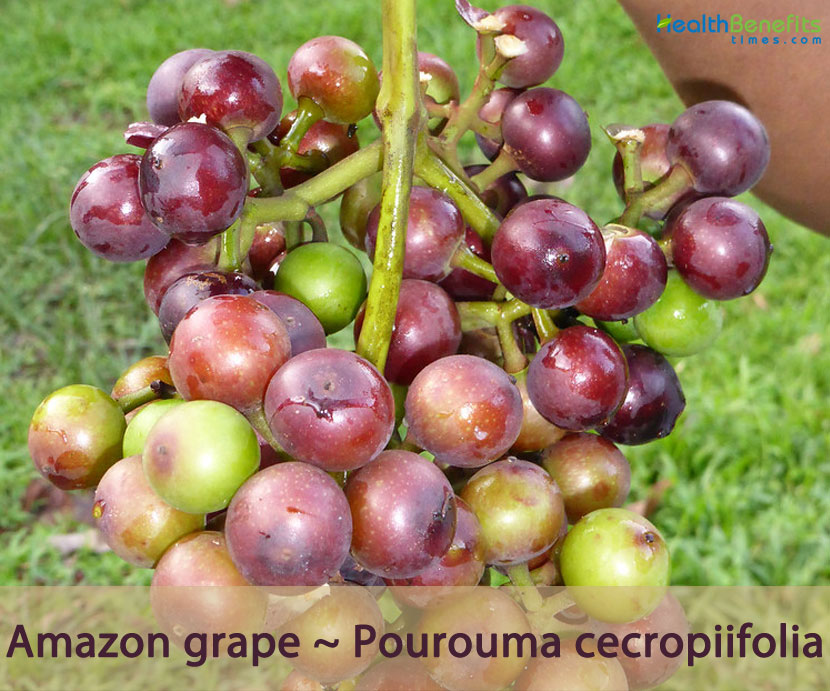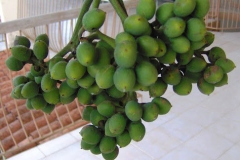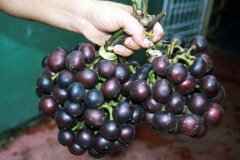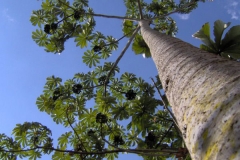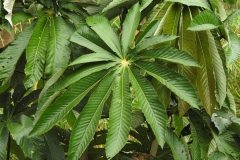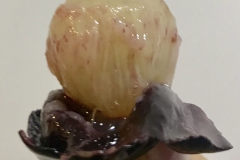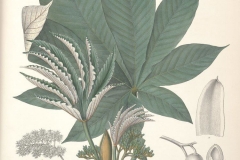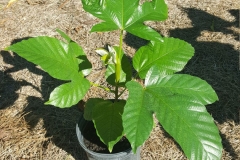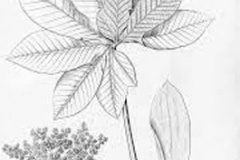| Amazon grape Quick Facts | |
|---|---|
| Name: | Amazon grape |
| Scientific Name: | Pourouma cecropiifolia |
| Origin | Tropical rainforests of Western Brazil, Ecuador, Bolivia and Peru |
| Colors | Green turning reddish- purple to dark purple when ripe |
| Shapes | Ovoid to globose, drupaceous fruit 2–4 cm long, and borne in clusters like grapes with the exception of its smell |
| Flesh colors | White |
| Health benefits | Good for treating hard boils |
| Name | Amazon grape |
|---|---|
| Scientific Name | Pourouma cecropiifolia |
| Native | Tropical rainforests of Western Brazil, Ecuador, Bolivia and Peru |
| Common Names | Amazon Grape, Amazon Tree Grape, Tree Grape, Uvilla, Washi shuinia, Mapati, Caimaron, Curcura, Peruma, Uva, Uvula |
| Name in Other Languages | Brazil: Tararanga Preta, Mapati, Amaitem, Ambaúva De Vinho, Ambaúva Mansa, Cucurca, Imbauba Mansa, Imbauba-De-Vinho, ImbaubaDeCheiro, Imbaubarana, Inbauba, Imbanbapuruma, Puruma, Sucuuba, Uva Da Amazônia, Uva Da Mata, Umbaúba De Cheiro, Umbaúba De Vinho Chinese: Yàmǎxùn pútáo (亞馬遜葡萄) Columbia: Puruma, Caime, Caimaron, Caimaron Silvestre, Uva Caimarona, Camuirro, Cucura, Uva, Sirpe, Hiye, Joyahiye English: Amazon grape, Amazon Tree Grape; Tree Grape, Uvilla French: Caimaron French Guyana: Uvilla, Uva De Monte, Uva Caimarona, Caimarõn, Caimurro, Peru Uvilla, Uva De Monte, Sacha Uvillas Korean: Ubiya (우비야) Peru: Uva de Monte, uvilla Persian: انگور آمازون Portuguese: Cucura, Imbauba De Vinho, Mapate, Puruma, Umbauba De Cheiro, Uva De Mata, Embaúba, Mapati, imbauba-do-vinho Russian: Amazonskiy vinograd (Амазонский виноград) Spanish: Caima, Caimaren, Uva Caimarona, Uva De Monte, Uvilla, Sacha-uvilla, Uva-caimarona Welsh: Ffa |
| Plant Growth Habit | Medium-sized, evergreen, dioecious, branched tree |
| Soil | Grows well on poor soils but prefers rich, well-drained soils and is vulnerable to flooding. It cannot stand prolonged drought and frost |
| Plant Size | Up to 20 meters tall, but is often smaller, and has a straight bole 20 – 30 cm in diameter |
| Bark | Bark is gray and marked with leaf scars |
| Leaf | Alternate, cordaterotund and palmately compound, with 9–11 leaflets, 15–30 cm long and 10–20 cm broad, on a 20 cm long, glabrous petiole. Segments are obovate-oblong- lanceolate and velvety |
| Flower | The white male and female flowers are borne in cluster of 20 or more in a 10 cm long inflorescence on separate trees. Male flowers with 4 free, strap-shaped sepals, with 4 or more stamens and basifixed anthers on short filaments, Female flowers with cup-shaped, fleshy perianth cup investing the one-celled, tomentosa ovary with a short style and slightly lobed stigma |
| Fruit Shape & Size | The fruit is ovoid to globose, drupaceous fruit 2–4 cm long, and borne in clusters like grapes with the exception of its smell |
| Fruit Color | Initially green turning reddish- purple to dark purple when ripe |
| Skin | Rough, inedible but easily peeled |
| Flesh Color | White |
| Propagation | By seed |
| Traditional Medicinal Uses |
|
Plant Description
Amazon grape is a medium-sized, evergreen, dioecious, branched tree that normally grows up to 20 meters tall, but is often smaller, and has a straight bole 20 – 30 cm in diameter. The plant has grey bark marked by leaf scars with a rosette of branches high up the tree and leaves crowded toward the tips of the branches. The plant grows well on poor soils but prefers rich, well-drained soils and is vulnerable to flooding. It cannot stand prolonged drought and frost.
Leaves
Leaves are alternate, cordaterotund and palmately compound, with 9–11 leaflets, 15–30 cm long and 10–20 cm broad, on a 20 cm long, glabrous petiole. Segments are obovate-oblong- lanceolate and velvety. They are green on the upper surface, whitish or bluish gray and velvety below, the largest middle ones, all more or less connate toward the base. The leaves give off an agreeably aromatic fragrance when crushed like wintergreen.
Flower
Inflorescence is erect, narrow, many- flowered axillary panicle. The unopened inflorescence is reddish-purple, densely coated with fine white hairs. The white male and female flowers are borne in cluster of 20 or more in a 10 cm long inflorescence on separate trees. Male flowers with 4 free, strap-shaped sepals, with 4 or more stamens and basifixed anthers on short filaments, Female flowers with cup-shaped, fleshy perianth cup investing the one-celled, tomentosa ovary with a short style and slightly lobed stigma.
Fruit
Fertile flowers are followed by ovoid to globose, drupaceous fruit 2–4 cm long, and borne in clusters like grapes with the exception of its smell. Fruit are initially green turning to reddish- purple and finally dark purple when ripe. The skin is rough, inedible but easily peeled. The pulp is white, mucilaginous, juicy, sub acid, very mild flavor; and encloses 1 conical seed with fibrous, grooved testa. However, fruits of Amazon grape are quite fragile and have a short shelf life too. This is the reason that its cultivation has not been able to pick up in spite of being a good and a popular fruit too.
Native American mythology
Ermanno Stradelli published at the end of the nineteenth century the Legenda del Jurupary, which speaks from a mythical point of view of the questions of language and birth in the ancient indigenous societies of Río Negro and the Middle Amazon. During this story, Seucy, a very pretty girl, goes into the forest and picks up some Pihican fruit that has fallen to the ground because of monkeys. She eats these fruits and juice flows between her breasts to her private parts without her noticing. Later she discovers that she has lost her virginity and that she finds herself pregnant. She will eventually give birth to a beautiful boy who looks like the sun and is called Jurupary, that is to say “conceived by the fruit”. Jurupary later became chief and legislator of the village.
Culinary Uses
- Fruit is sweet and juicy, eaten fresh and made into jams, jellies, other confections and wine.
- Fruit is very fragile and has poor post-harvest shelf-life which limits marketing options.
- The sweet flower perianth is eaten raw or used for making drinks and wine.
- The toasted seeds can be used as a substitute for coffee and the leaf ash is sometimes substituted as a coca additive.
- Some people also make a wine from Amazon grapes.
Other Facts
- The wood is light, coarse and non-durable and used for paper pulp and for making charcoal.
- The wood is unsuitable for furniture or general construction.
- It is used for linings, boxes, toys and plywood.
- It is also pulped for cellulose.
- In Southwest Columbia, Indians reduce the leaves to ashes to mix with roasted and sprayed coca leaves to chew them into a fine powder called mambe.
- Mature tree can yield 50-70 kg of fruits.
References:
https://pfaf.org/user/Plant.aspx?LatinName=Pourouma+cecropiifolia
https://gd.eppo.int/taxon/POUCE
http://www.theplantlist.org/tpl1.1/record/kew-2408635
http://tropical.theferns.info/viewtropical.php?id=Pourouma+cecropiifolia
https://en.wikipedia.org/wiki/Pourouma_cecropiifolia
https://hort.purdue.edu/newcrop/morton/Amazon-Tree-Grape.html


